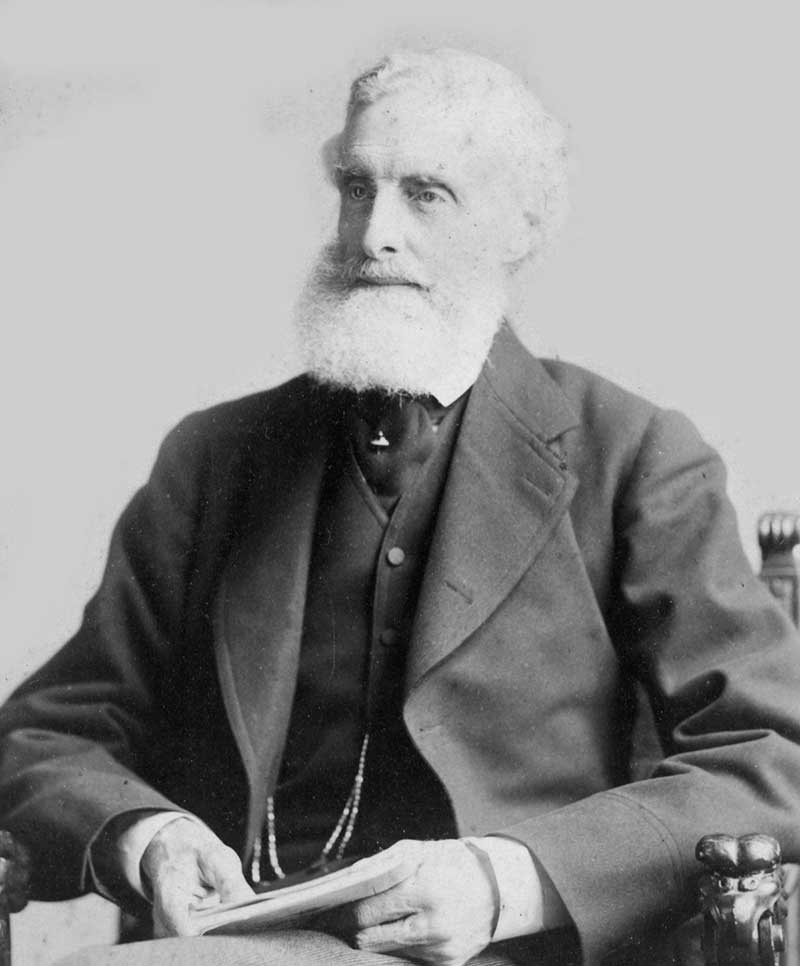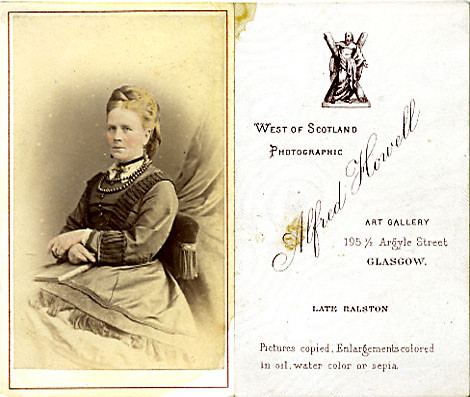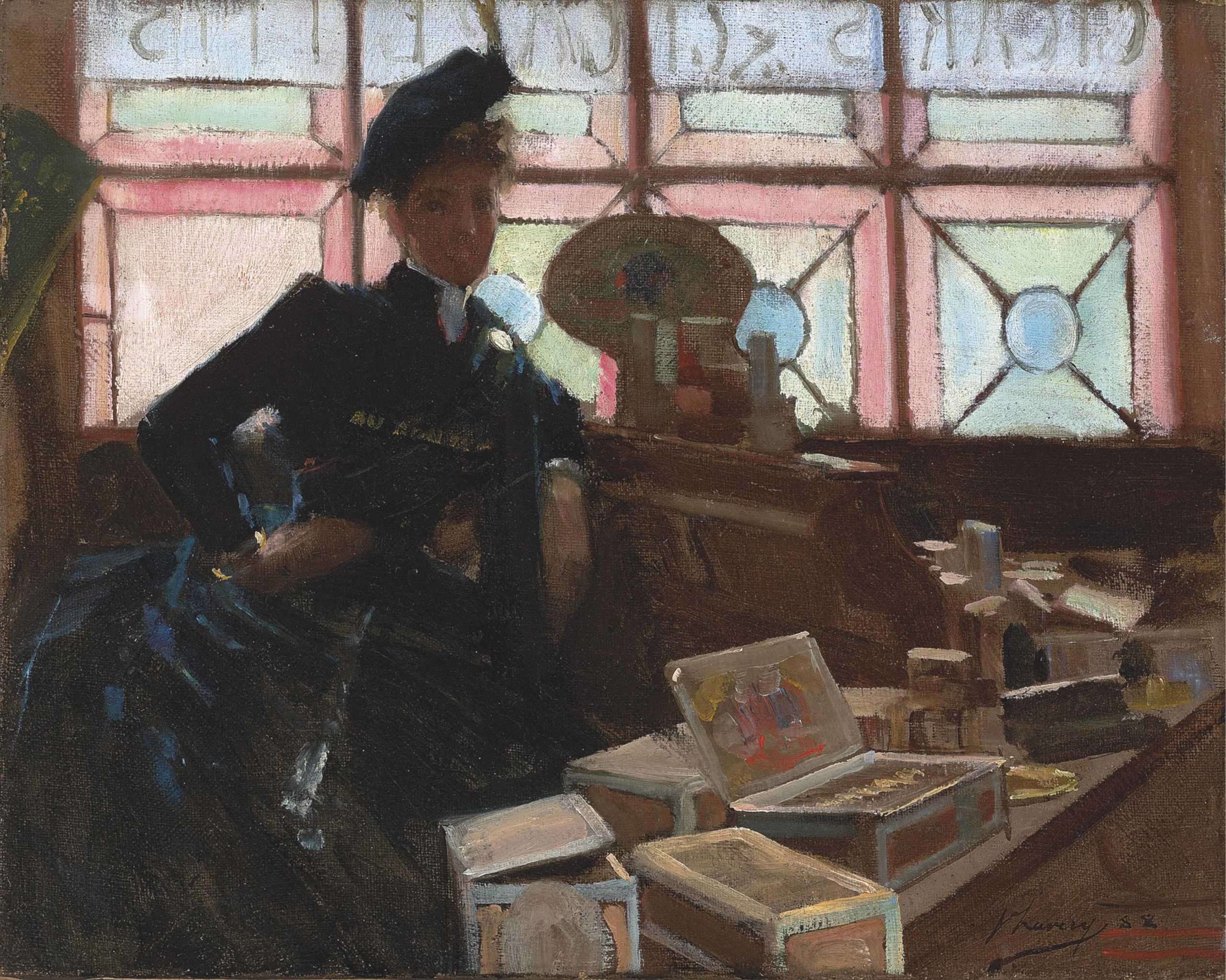Here’s another few random former Strathbungo residents, plucked from the database, these ones from 26 Marywood Square.
Duncan Graham, Leather Merchant
Our records show that the house, then known as 12 Princes Square, was first occupied in 1879, by one W Simpson. By 1885 the tenant was Duncan Graham, and the owner William Weir. Weir was the father of Robert Weir, the builder of the terrace; and in the 1885 valuation roll he owned most of the terrace, following his son’s untimely death. According to the Valuation rolls, ownership later passed to W Fairlees Trustees, who had financed the building, and took the building back when the debt was not repaid. A Herald advert in 1902 records the sale of both 26 and 24 by the Fairlies by public roup, the former apparently to Lachlan Seymour Graham, Duncan’s own son. However by 1915 Duncan was gone and the house had been sold to Andrew Nicol Campbell Smith.
Duncan was a saddler, and a leather merchant and manufacturer in Glasgow, married to Isabelle McLachlan. He had an interest in politics and public life. He was one of the original members of the Glasgow Liberal Club, a past President of the Eighth and Broomielaw Municipal Wards, and the Director of the Glasgow Agricultural Society. He was also a keen cricketer and golfer.
Their son Lachlan was born in 1882, and later graduated from the University of Glasgow, and qualified as a lawyer, which may explain how he came to own his father’s house, perhaps managing his finances. He later signed up with the Highland Light Infantry during the Great War. A biography is reproduced below from the University of Glasgow & Scotland’s War .
Second Lieutenant Lachlan Seymour Graham
7th/12th (Service) Battalion, Highland Light Infantry, born on 19 September 1882 in Glasgow.
Lachlan went up to the University of Glasgow in 1900 to begin his studies for an Arts degree. He took many subjects, including Latin, Logic and Moral Philosophy. In his final years in Arts he discovered his strong suits, and did well in Political Economy and in James Irvine’s class of Civil law, in which he took 11th equal place. Perhaps it was that success which encouraged him to take up law. After graduating MA in 1905 he matriculated again for Scots Law and over the next few years gradually put together a BL. He graduated for a second time in 1910.
Before the war he had been Secretary of Glasgow Business Club, Treasurer of West of Scotland Lawn Tennis Club and Manager of Renfield Street United Free Church.
It was while he was forging his way in the legal profession as sole partner of Messrs. Hubbard & Seymour Graham, Glasgow, that he decided to join up. Lachlan took a commission as 2nd Lieutenant in the 7/12th (Service) Bn. Highland Light Infantry. It was at Passchendaele, the very name of which evokes the image of so much loss and waste in muddy quagmires, that he was fatally wounded.
Lieutenant Lachlan Seymour Graham was wounded in action on 23 August 1917, and died at a Casualty Clearing Station on 29 August 1917, age 34. He is buried at Lijssenthoek Military Cemetery, near Ypres (Ieper), Belgium and is also commemorated in Helensburgh Cemetery .

Lachlan Seymour Graham Memorial, Helensburgh Cemetery
Andrew Nicol Campbell Smith
Andrew was the youngest of nine children, the son of George Cruikshank Smith of Banffshire, who was the Secretary of the Northern assurance Company, and Mary Stewart of Campbelltown. In the 1890s up until around 1905 the family was living at 44 Princes Square in Strathbungo (now 17 Marywood Square), although Mary was widowed; George had died young in 1872.
Andrew was an accountant and auditor. In 1906 he married Isa MacNair and settled at 45 Fotheringay Road. John Bennie Wilson, the architect who features elsewhere in these pages, lived on the same close. They had a daughter Isobel in 1908, and a few years later moved to 12 Princes Square. Andrew had an office at 78 St Vincent Street around this time. He later moved to Clarkston, where he died in 1942. Isa died in 1952. Curiously, their gravestone in Cathcart Cemetery also lists their son George Huntly, who died on 10 April 1918, but I can find no record of his existence.
Alfred Howell, Tobacconist
By 1925 the house had passed to Alfred Howell, a cigar importer whose premises were at the corner of Argyle & Union Streets, where KFC is now.

Corner of Argyle & Union Streets, with the awnings of Howell’s shop visible. Source; Glasgow City Archives

Alfred Howell
Alfred Howell himself is an interesting character; born in Belfast in 1843 to a merchant sea captain, he married Elizabeth McLay Brown, a seamstress, in Greenock in 1869, and raised a large family, latterly at Ontario, 43 Maxwell Drive in Pollokshields. After the death of his wife he spent his last few years in Strathbungo, and died in Glasgow in 1927 . He was a photographer as well as a tobacconist and cigar importer, and some of his cartes de visite still exist, this one from 1873 .

Alfred Howell Carte de Visite 1873
In 1888 he had the concession for the tobacco kiosk at the 1888 International Exhibition. This was no mere kiosk, but a two story oriental construction with smoking lounge upstairs, paired with an adjacent florist and confectioners . There were two such kiosks, designed by James Sellars.

Glasgow International Exhibition 1888. Howell’s tobacco kiosk, centre.

Howell’s tobacco kiosk
The Irish artist Sir John Lavery painted scenes at the exhibition and achieved fame by being commissioned to paint Queen Victoria’s visit. His depiction of a cigar seller in Howell’s kiosk was the most popular of his exhibition paintings and fetched £134,000 in 2014 .

The Guild of Aid
At some point 26 Marywood Square and several other properties in Strathbungo were purchased by the Guild of Aid, and only disposed of in the 1990s. The Guild was a charity that worked with women and children in the Gorbals. It set up a nursery for the children of working mothers, charging 1 shilling (5p) a week, ran cookery classes, provided cheap clothing and organised “fresh-air fortnights” for women and children to take holidays away from the city. It was most notably run by social worker Marald Grant from the 1920s to the 1960s; she also ran an adoption agency for illegitimate children. The National Library of Scotland has film footage taken by Marald Grant depicting the Guild’s work .
The house at 26 Marywood Square has a small plaque by the door; “Weir House”. The plaque is too new to be related to the early owner, William Weir, and actually honours the Guild’s president, the Second Viscount Weir, of Cathcart’s Weir engineering family, and his wife. The Third Viscount was also subsequently a president.
Subsequent investigations into the history of the Guild of Aid and its houses in Strathbungo are described in a separate article.
References
{3557955:VZDBM4QS},{3557955:DRRQ2B7M};{3557955:EVIWXTAG};{3557955:GI98BLP6};{3557955:SWVU3HN2};{3557955:7Z28LRLJ};{3557955:68677MRW};{3557955:N5VDRUYC}
vancouver
asc
0
2857
%7B%22status%22%3A%22success%22%2C%22updateneeded%22%3Afalse%2C%22instance%22%3A%22zotpress-052d164549101be6629fc2bc10ae70a1%22%2C%22meta%22%3A%7B%22request_last%22%3A0%2C%22request_next%22%3A0%2C%22used_cache%22%3Atrue%7D%2C%22data%22%3A%5B%7B%22key%22%3A%22N5VDRUYC%22%2C%22library%22%3A%7B%22id%22%3A3557955%7D%2C%22meta%22%3A%7B%22numChildren%22%3A1%7D%2C%22bib%22%3A%22%3Cdiv%20class%3D%5C%22csl-bib-body%5C%22%20style%3D%5C%22line-height%3A%201.35%3B%20%5C%22%3E%5Cn%20%20%3Cdiv%20class%3D%5C%22csl-entry%5C%22%20style%3D%5C%22clear%3A%20left%3B%20%5C%22%3E%5Cn%20%20%20%20%3Cdiv%20class%3D%5C%22csl-left-margin%5C%22%20style%3D%5C%22float%3A%20left%3B%20padding-right%3A%200.5em%3B%20text-align%3A%20right%3B%20width%3A%201em%3B%5C%22%3E1.%3C%5C%2Fdiv%3E%3Cdiv%20class%3D%5C%22csl-right-inline%5C%22%20style%3D%5C%22margin%3A%200%20.4em%200%201.5em%3B%5C%22%3EFull%20record%20for%20%26%23x201C%3BGUILD%20OF%20AID%20WORK%20IN%20THE%20GORBALS%26%23x201D%3B%20%280531%29%20-%20Moving%20Image%20Archive%20catalogue%20%5BInternet%5D.%20%5Bcited%202020%20Dec%203%5D.%20Available%20from%3A%20%3Ca%20href%3D%27https%3A%5C%2F%5C%2Fmovingimage.nls.uk%5C%2Ffilm%5C%2F0531%27%3Ehttps%3A%5C%2F%5C%2Fmovingimage.nls.uk%5C%2Ffilm%5C%2F0531%3C%5C%2Fa%3E%3C%5C%2Fdiv%3E%5Cn%20%20%3C%5C%2Fdiv%3E%5Cn%3C%5C%2Fdiv%3E%22%2C%22data%22%3A%7B%22itemType%22%3A%22webpage%22%2C%22title%22%3A%22Full%20record%20for%20%27GUILD%20OF%20AID%20WORK%20IN%20THE%20GORBALS%27%20%280531%29%20-%20Moving%20Image%20Archive%20catalogue%22%2C%22creators%22%3A%5B%5D%2C%22abstractNote%22%3A%22%22%2C%22date%22%3A%22%22%2C%22url%22%3A%22https%3A%5C%2F%5C%2Fmovingimage.nls.uk%5C%2Ffilm%5C%2F0531%22%2C%22language%22%3A%22%22%2C%22collections%22%3A%5B%22CAR6MXPM%22%5D%2C%22dateModified%22%3A%222020-12-03T21%3A41%3A58Z%22%7D%7D%2C%7B%22key%22%3A%22GI98BLP6%22%2C%22library%22%3A%7B%22id%22%3A3557955%7D%2C%22meta%22%3A%7B%22numChildren%22%3A1%7D%2C%22bib%22%3A%22%3Cdiv%20class%3D%5C%22csl-bib-body%5C%22%20style%3D%5C%22line-height%3A%201.35%3B%20%5C%22%3E%5Cn%20%20%3Cdiv%20class%3D%5C%22csl-entry%5C%22%20style%3D%5C%22clear%3A%20left%3B%20%5C%22%3E%5Cn%20%20%20%20%3Cdiv%20class%3D%5C%22csl-left-margin%5C%22%20style%3D%5C%22float%3A%20left%3B%20padding-right%3A%200.5em%3B%20text-align%3A%20right%3B%20width%3A%201em%3B%5C%22%3E1.%3C%5C%2Fdiv%3E%3Cdiv%20class%3D%5C%22csl-right-inline%5C%22%20style%3D%5C%22margin%3A%200%20.4em%200%201.5em%3B%5C%22%3EFamily%20History%20-%20John%20Brown%20%5BInternet%5D.%20%5Bcited%202020%20Nov%2026%5D.%20Available%20from%3A%20%3Ca%20href%3D%27http%3A%5C%2F%5C%2Fwww.the-malvern-hills.uk%5C%2Ffamily_history_brown.htm%27%3Ehttp%3A%5C%2F%5C%2Fwww.the-malvern-hills.uk%5C%2Ffamily_history_brown.htm%3C%5C%2Fa%3E%3C%5C%2Fdiv%3E%5Cn%20%20%3C%5C%2Fdiv%3E%5Cn%3C%5C%2Fdiv%3E%22%2C%22data%22%3A%7B%22itemType%22%3A%22webpage%22%2C%22title%22%3A%22Family%20History%20-%20John%20Brown%22%2C%22creators%22%3A%5B%5D%2C%22abstractNote%22%3A%22%22%2C%22date%22%3A%22%22%2C%22url%22%3A%22http%3A%5C%2F%5C%2Fwww.the-malvern-hills.uk%5C%2Ffamily_history_brown.htm%22%2C%22language%22%3A%22%22%2C%22collections%22%3A%5B%22CAR6MXPM%22%5D%2C%22dateModified%22%3A%222020-11-26T21%3A08%3A19Z%22%7D%7D%2C%7B%22key%22%3A%22SWVU3HN2%22%2C%22library%22%3A%7B%22id%22%3A3557955%7D%2C%22meta%22%3A%7B%22numChildren%22%3A1%7D%2C%22bib%22%3A%22%3Cdiv%20class%3D%5C%22csl-bib-body%5C%22%20style%3D%5C%22line-height%3A%201.35%3B%20%5C%22%3E%5Cn%20%20%3Cdiv%20class%3D%5C%22csl-entry%5C%22%20style%3D%5C%22clear%3A%20left%3B%20%5C%22%3E%5Cn%20%20%20%20%3Cdiv%20class%3D%5C%22csl-left-margin%5C%22%20style%3D%5C%22float%3A%20left%3B%20padding-right%3A%200.5em%3B%20text-align%3A%20right%3B%20width%3A%201em%3B%5C%22%3E1.%3C%5C%2Fdiv%3E%3Cdiv%20class%3D%5C%22csl-right-inline%5C%22%20style%3D%5C%22margin%3A%200%20.4em%200%201.5em%3B%5C%22%3EGLASGOW%26%23x2019%3BS%20VICTORIAN%20PHOTOGRAPHERS%20%5BInternet%5D.%20%5Bcited%202020%20Nov%2026%5D.%20Available%20from%3A%20%3Ca%20href%3D%27http%3A%5C%2F%5C%2Fwww.thelows.madasafish.com%5C%2Fcards%5C%2Fhowell.htm%27%3Ehttp%3A%5C%2F%5C%2Fwww.thelows.madasafish.com%5C%2Fcards%5C%2Fhowell.htm%3C%5C%2Fa%3E%3C%5C%2Fdiv%3E%5Cn%20%20%3C%5C%2Fdiv%3E%5Cn%3C%5C%2Fdiv%3E%22%2C%22data%22%3A%7B%22itemType%22%3A%22webpage%22%2C%22title%22%3A%22GLASGOW%27S%20VICTORIAN%20PHOTOGRAPHERS%22%2C%22creators%22%3A%5B%5D%2C%22abstractNote%22%3A%22%22%2C%22date%22%3A%22%22%2C%22url%22%3A%22http%3A%5C%2F%5C%2Fwww.thelows.madasafish.com%5C%2Fcards%5C%2Fhowell.htm%22%2C%22language%22%3A%22%22%2C%22collections%22%3A%5B%22CAR6MXPM%22%5D%2C%22dateModified%22%3A%222020-11-26T21%3A08%3A15Z%22%7D%7D%2C%7B%22key%22%3A%2268677MRW%22%2C%22library%22%3A%7B%22id%22%3A3557955%7D%2C%22meta%22%3A%7B%22numChildren%22%3A1%7D%2C%22bib%22%3A%22%3Cdiv%20class%3D%5C%22csl-bib-body%5C%22%20style%3D%5C%22line-height%3A%201.35%3B%20%5C%22%3E%5Cn%20%20%3Cdiv%20class%3D%5C%22csl-entry%5C%22%20style%3D%5C%22clear%3A%20left%3B%20%5C%22%3E%5Cn%20%20%20%20%3Cdiv%20class%3D%5C%22csl-left-margin%5C%22%20style%3D%5C%22float%3A%20left%3B%20padding-right%3A%200.5em%3B%20text-align%3A%20right%3B%20width%3A%201em%3B%5C%22%3E1.%3C%5C%2Fdiv%3E%3Cdiv%20class%3D%5C%22csl-right-inline%5C%22%20style%3D%5C%22margin%3A%200%20.4em%200%201.5em%3B%5C%22%3ESir%20John%20Lavery%2C%20R.A.%2C%20R.S.A.%2C%20R.H.A.%20%281856-1941%29%20%2C%20The%20Cigar%20Seller%20at%20the%20Glasgow%20Exhibition%20%5BInternet%5D.%20%5Bcited%202020%20Nov%2026%5D.%20Available%20from%3A%20%3Ca%20href%3D%27https%3A%5C%2F%5C%2Fwww.christies.com%5C%2Flotfinder%5C%2Flot_details.aspx%3FintObjectID%3D5844191%27%3Ehttps%3A%5C%2F%5C%2Fwww.christies.com%5C%2Flotfinder%5C%2Flot_details.aspx%3FintObjectID%3D5844191%3C%5C%2Fa%3E%3C%5C%2Fdiv%3E%5Cn%20%20%3C%5C%2Fdiv%3E%5Cn%3C%5C%2Fdiv%3E%22%2C%22data%22%3A%7B%22itemType%22%3A%22webpage%22%2C%22title%22%3A%22Sir%20John%20Lavery%2C%20R.A.%2C%20R.S.A.%2C%20R.H.A.%20%281856-1941%29%20%2C%20The%20Cigar%20Seller%20at%20the%20Glasgow%20Exhibition%22%2C%22creators%22%3A%5B%5D%2C%22abstractNote%22%3A%22The%20Cigar%20Seller%20at%20the%20Glasgow%20Exhibition%22%2C%22date%22%3A%22%22%2C%22url%22%3A%22https%3A%5C%2F%5C%2Fwww.christies.com%5C%2Flotfinder%5C%2Flot_details.aspx%3FintObjectID%3D5844191%22%2C%22language%22%3A%22en%22%2C%22collections%22%3A%5B%22CAR6MXPM%22%5D%2C%22dateModified%22%3A%222020-11-26T20%3A57%3A34Z%22%7D%7D%2C%7B%22key%22%3A%227Z28LRLJ%22%2C%22library%22%3A%7B%22id%22%3A3557955%7D%2C%22meta%22%3A%7B%22creatorSummary%22%3A%22Spooner%22%2C%22parsedDate%22%3A%222019-09-02%22%2C%22numChildren%22%3A1%7D%2C%22bib%22%3A%22%3Cdiv%20class%3D%5C%22csl-bib-body%5C%22%20style%3D%5C%22line-height%3A%201.35%3B%20%5C%22%3E%5Cn%20%20%3Cdiv%20class%3D%5C%22csl-entry%5C%22%20style%3D%5C%22clear%3A%20left%3B%20%5C%22%3E%5Cn%20%20%20%20%3Cdiv%20class%3D%5C%22csl-left-margin%5C%22%20style%3D%5C%22float%3A%20left%3B%20padding-right%3A%200.5em%3B%20text-align%3A%20right%3B%20width%3A%201em%3B%5C%22%3E1.%3C%5C%2Fdiv%3E%3Cdiv%20class%3D%5C%22csl-right-inline%5C%22%20style%3D%5C%22margin%3A%200%20.4em%200%201.5em%3B%5C%22%3ESpooner%20R.%20Day-Tripping%3A%20Urban%20Excursions%20and%20the%20Architecture%20of%20International%20Exhibitions.%20Architectural%20Theory%20Review%20%5BInternet%5D.%202019%20Sep%202%20%5Bcited%202020%20Nov%2026%5D%3B23%283%29%3A326%26%23x2013%3B44.%20Available%20from%3A%20%3Ca%20href%3D%27https%3A%5C%2F%5C%2Fwww.tandfonline.com%5C%2Fdoi%5C%2Ffull%5C%2F10.1080%5C%2F13264826.2019.1698398%27%3Ehttps%3A%5C%2F%5C%2Fwww.tandfonline.com%5C%2Fdoi%5C%2Ffull%5C%2F10.1080%5C%2F13264826.2019.1698398%3C%5C%2Fa%3E%3C%5C%2Fdiv%3E%5Cn%20%20%3C%5C%2Fdiv%3E%5Cn%3C%5C%2Fdiv%3E%22%2C%22data%22%3A%7B%22itemType%22%3A%22journalArticle%22%2C%22title%22%3A%22Day-Tripping%3A%20Urban%20Excursions%20and%20the%20Architecture%20of%20International%20Exhibitions%22%2C%22creators%22%3A%5B%7B%22creatorType%22%3A%22author%22%2C%22firstName%22%3A%22Rosemary%22%2C%22lastName%22%3A%22Spooner%22%7D%5D%2C%22abstractNote%22%3A%22This%20article%20examines%20how%20the%20architecture%20of%20international%20exhibitions%20stimulated%20sensations%20of%20moving%20through%20space%20and%20time.%20It%20conducts%20a%20detailed%20study%20of%20the%20principal%20structures%20of%20the%20Glasgow%20International%20Exhibition%20of%201888%2C%20the%20first%20in%20a%20series%20of%20highly%20successful%20events%20mounted%20in%20the%20so-called%20%5Cu201csecond%20city%20of%20the%20empire.%5Cu201d%20Through%20analysing%20pictorial%20representations%20and%20textual%20descriptions%2C%20it%20reconstructs%20the%20exhibition%5Cu2019s%20physical%20environment%20and%20atmosphere%2C%20which%20were%20perceived%20as%20%5Cu201coriental%5Cu201d%20in%20character%20by%20contemporary%20commentators%2C%20in%20order%20to%20probe%20how%20the%20architecture%20of%20international%20exhibitions%20helped%20render%20these%20events%20sites%20of%20imperial%20meaning-making.%20Following%20an%20interdisciplinary%20approach%20informed%20by%20architectural%20and%20design%20history%2C%20postcolonial%20analyses%20of%20the%20relationship%20between%20nation%20and%20empire%2C%20and%20critical%20museology%2C%20it%20frames%20the%20international%20exhibition%20as%20a%20ritual%20site%20and%20argues%20that%20exhibition%20architecture%20played%20a%20key%20role%20in%20producing%20a%20liminal%20experience%20for%20visitors.%22%2C%22date%22%3A%222019-09-02%22%2C%22language%22%3A%22en%22%2C%22DOI%22%3A%2210.1080%5C%2F13264826.2019.1698398%22%2C%22ISSN%22%3A%221326-4826%2C%201755-0475%22%2C%22url%22%3A%22https%3A%5C%2F%5C%2Fwww.tandfonline.com%5C%2Fdoi%5C%2Ffull%5C%2F10.1080%5C%2F13264826.2019.1698398%22%2C%22collections%22%3A%5B%22CAR6MXPM%22%5D%2C%22dateModified%22%3A%222020-11-26T20%3A51%3A30Z%22%7D%7D%2C%7B%22key%22%3A%22EVIWXTAG%22%2C%22library%22%3A%7B%22id%22%3A3557955%7D%2C%22meta%22%3A%7B%22numChildren%22%3A1%7D%2C%22bib%22%3A%22%3Cdiv%20class%3D%5C%22csl-bib-body%5C%22%20style%3D%5C%22line-height%3A%201.35%3B%20%5C%22%3E%5Cn%20%20%3Cdiv%20class%3D%5C%22csl-entry%5C%22%20style%3D%5C%22clear%3A%20left%3B%20%5C%22%3E%5Cn%20%20%20%20%3Cdiv%20class%3D%5C%22csl-left-margin%5C%22%20style%3D%5C%22float%3A%20left%3B%20padding-right%3A%200.5em%3B%20text-align%3A%20right%3B%20width%3A%201em%3B%5C%22%3E1.%3C%5C%2Fdiv%3E%3Cdiv%20class%3D%5C%22csl-right-inline%5C%22%20style%3D%5C%22margin%3A%200%20.4em%200%201.5em%3B%5C%22%3ELACHLAN%20SEYMOUR%20GRAHAM%20%7C%20Lijssenthoek%20%5BInternet%5D.%20%5Bcited%202020%20Nov%2026%5D.%20Available%20from%3A%20%3Ca%20href%3D%27http%3A%5C%2F%5C%2Fwww.lijssenthoek.be%5C%2Fen%5C%2Faddress%5C%2F7176%5C%2F-lachlan-seymour-graham.html%27%3Ehttp%3A%5C%2F%5C%2Fwww.lijssenthoek.be%5C%2Fen%5C%2Faddress%5C%2F7176%5C%2F-lachlan-seymour-graham.html%3C%5C%2Fa%3E%3C%5C%2Fdiv%3E%5Cn%20%20%3C%5C%2Fdiv%3E%5Cn%3C%5C%2Fdiv%3E%22%2C%22data%22%3A%7B%22itemType%22%3A%22webpage%22%2C%22title%22%3A%22LACHLAN%20SEYMOUR%20GRAHAM%20%7C%20Lijssenthoek%22%2C%22creators%22%3A%5B%5D%2C%22abstractNote%22%3A%22%22%2C%22date%22%3A%22%22%2C%22url%22%3A%22http%3A%5C%2F%5C%2Fwww.lijssenthoek.be%5C%2Fen%5C%2Faddress%5C%2F7176%5C%2F-lachlan-seymour-graham.html%22%2C%22language%22%3A%22%22%2C%22collections%22%3A%5B%22CAR6MXPM%22%5D%2C%22dateModified%22%3A%222020-11-26T19%3A08%3A27Z%22%7D%7D%2C%7B%22key%22%3A%22VZDBM4QS%22%2C%22library%22%3A%7B%22id%22%3A3557955%7D%2C%22meta%22%3A%7B%22numChildren%22%3A1%7D%2C%22bib%22%3A%22%3Cdiv%20class%3D%5C%22csl-bib-body%5C%22%20style%3D%5C%22line-height%3A%201.35%3B%20%5C%22%3E%5Cn%20%20%3Cdiv%20class%3D%5C%22csl-entry%5C%22%20style%3D%5C%22clear%3A%20left%3B%20%5C%22%3E%5Cn%20%20%20%20%3Cdiv%20class%3D%5C%22csl-left-margin%5C%22%20style%3D%5C%22float%3A%20left%3B%20padding-right%3A%200.5em%3B%20text-align%3A%20right%3B%20width%3A%201em%3B%5C%22%3E1.%3C%5C%2Fdiv%3E%3Cdiv%20class%3D%5C%22csl-right-inline%5C%22%20style%3D%5C%22margin%3A%200%20.4em%200%201.5em%3B%5C%22%3EUniversity%20of%20Glasgow%26%23x202F%3B%3A%3A%20Story%26%23x202F%3B%3A%3A%20Biography%20of%20Lieutenant%20Lachlan%20Seymour%20Graham%20%5BInternet%5D.%20%5Bcited%202020%20Nov%2026%5D.%20Available%20from%3A%20%3Ca%20href%3D%27https%3A%5C%2F%5C%2Fwww.universitystory.gla.ac.uk%5C%2Fww1-biography%5C%2F%3Fid%3D645%27%3Ehttps%3A%5C%2F%5C%2Fwww.universitystory.gla.ac.uk%5C%2Fww1-biography%5C%2F%3Fid%3D645%3C%5C%2Fa%3E%3C%5C%2Fdiv%3E%5Cn%20%20%3C%5C%2Fdiv%3E%5Cn%3C%5C%2Fdiv%3E%22%2C%22data%22%3A%7B%22itemType%22%3A%22webpage%22%2C%22title%22%3A%22University%20of%20Glasgow%20%3A%3A%20Story%20%3A%3A%20Biography%20of%20Lieutenant%20Lachlan%20Seymour%20Graham%22%2C%22creators%22%3A%5B%5D%2C%22abstractNote%22%3A%22%22%2C%22date%22%3A%22%22%2C%22url%22%3A%22https%3A%5C%2F%5C%2Fwww.universitystory.gla.ac.uk%5C%2Fww1-biography%5C%2F%3Fid%3D645%22%2C%22language%22%3A%22%22%2C%22collections%22%3A%5B%22CAR6MXPM%22%5D%2C%22dateModified%22%3A%222020-11-26T19%3A08%3A01Z%22%7D%7D%2C%7B%22key%22%3A%22DRRQ2B7M%22%2C%22library%22%3A%7B%22id%22%3A3557955%7D%2C%22meta%22%3A%7B%22numChildren%22%3A1%7D%2C%22bib%22%3A%22%3Cdiv%20class%3D%5C%22csl-bib-body%5C%22%20style%3D%5C%22line-height%3A%201.35%3B%20%5C%22%3E%5Cn%20%20%3Cdiv%20class%3D%5C%22csl-entry%5C%22%20style%3D%5C%22clear%3A%20left%3B%20%5C%22%3E%5Cn%20%20%20%20%3Cdiv%20class%3D%5C%22csl-left-margin%5C%22%20style%3D%5C%22float%3A%20left%3B%20padding-right%3A%200.5em%3B%20text-align%3A%20right%3B%20width%3A%201em%3B%5C%22%3E1.%3C%5C%2Fdiv%3E%3Cdiv%20class%3D%5C%22csl-right-inline%5C%22%20style%3D%5C%22margin%3A%200%20.4em%200%201.5em%3B%5C%22%3EGraham%2C%20LS%20%5BInternet%5D.%20%5Bcited%202020%20Nov%2026%5D.%20Available%20from%3A%20%3Ca%20href%3D%27http%3A%5C%2F%5C%2Fwww.scotlandswar.co.uk%5C%2Fgraham_ls.html%27%3Ehttp%3A%5C%2F%5C%2Fwww.scotlandswar.co.uk%5C%2Fgraham_ls.html%3C%5C%2Fa%3E%3C%5C%2Fdiv%3E%5Cn%20%20%3C%5C%2Fdiv%3E%5Cn%3C%5C%2Fdiv%3E%22%2C%22data%22%3A%7B%22itemType%22%3A%22webpage%22%2C%22title%22%3A%22Graham%2C%20LS%22%2C%22creators%22%3A%5B%5D%2C%22abstractNote%22%3A%22%22%2C%22date%22%3A%22%22%2C%22url%22%3A%22http%3A%5C%2F%5C%2Fwww.scotlandswar.co.uk%5C%2Fgraham_ls.html%22%2C%22language%22%3A%22%22%2C%22collections%22%3A%5B%22CAR6MXPM%22%5D%2C%22dateModified%22%3A%222020-11-26T16%3A47%3A06Z%22%7D%7D%5D%7D
Like this:
Like Loading...








January 2, 2021 at 4:05 pm
Excellent research!
January 25, 2021 at 1:23 am
Fascinating stuff! I adore the four domed towers on the tobacconist’s kiosk – very much a colonialist building. Thanks for doing this research.